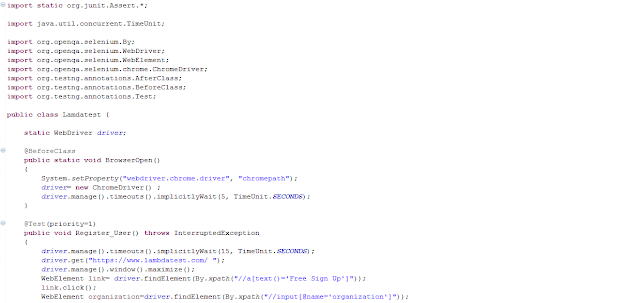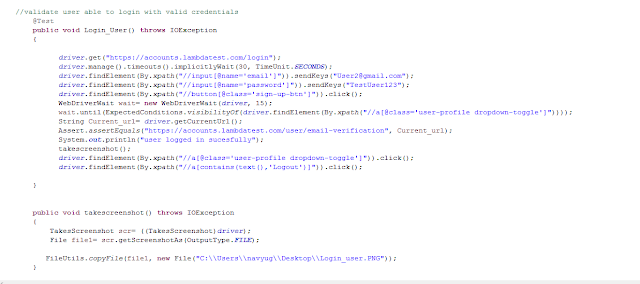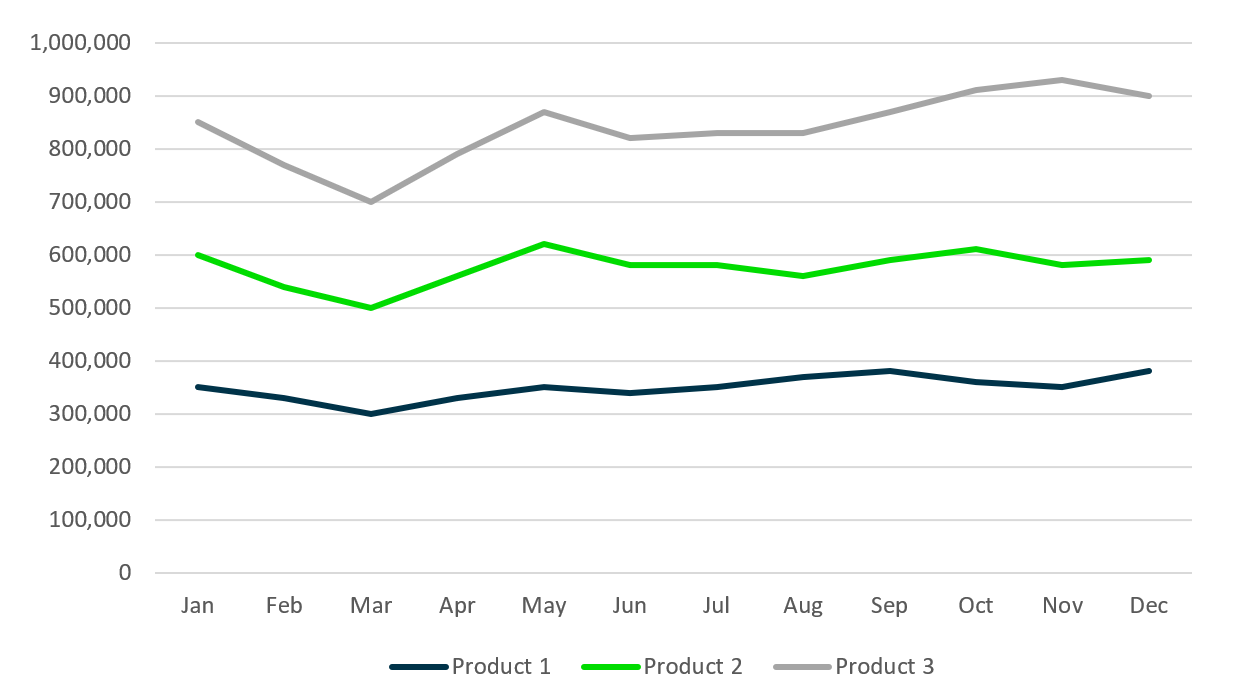As you start on with automation you may come across various approaches, techniques, framework and tools you may incorporate in your automation code. Sometimes such versatility leads to greater complexity in code than providing better flexibility or better means...
As you start on with automation you may
come across various approaches, techniques, framework and tools you may
incorporate in your automation code. Sometimes such versatility leads to
greater complexity in code than providing better flexibility or better means of
resolving issues.�While writing an automation code it�s important that we
are able to clearly portray our objective of automation testing and how are we
achieving it. Having said so it�s important to write �clean code� to provide
better maintainability and readability. Writing clean code is also not an easy
cup of tea, you need to keep in mind a lot of best practices. The below topic
highlights 8 silver lines one should acquire to write better automation code.
1.
Naming Convention
This is indeed one of the thumbs rules
to keep in mind as we move from�manual to automation�or in fact
writing code in any programming language. Following proper naming conventions
helps in easier understanding of code and maintenance. This naming convention
implies on variables, methods, classes and package. For example, your method
name should be specific as what it is intended for. A �Register_User()� method
portrays the method displaying user registration within that method. Clearly
defined method names add to the easy maintenance and readability of the script.
The same extends to the variable naming. I have noticed many people mentioning variable
as a, b, c etc or even Web Elements as Weblelement1, Webelement2 and so on.
This gives no clue to the user seeing the variable name as what it intends to
do.
Below is an example showing when
naming goes wrong:
The above code shows how
�method1� gives no clue to the user as what this method exactly does. Also, all
web elements are denoted via web1, web2�and so on. User cannot identify which
web element captures which field.
A correct way of representation can be marked
as follows for the same above code:
Here the method name
�Register_User� clearly defines user through name indicating this method
contains code related to the registration of the user. Similarly, all web
elements or variables are provided with names which relate to the captured
fields used for the defined intent.
Usually, using camel casing for writing down
methods or variables is usually encouraged for its better clarity in terms of
readability and maintaining the script.
2. The Three R�s-Reduce, Reuse and Recycle
It�s important to ensure your methods are
broken to the smallest chunks of user scenarios. They should cover simple and
single flows. Do not overcomplex your methods with multiple functionalities
covered in a single method. For example, a login feature needs the user to be
registered on the application. Keep your register feature into another method
and if required call that method in your login method. Reducing the complexity
of the methods leads to easy maintainability of the code.
Also, reuse your methods wherever required,
do not copy paste the same code in different methods. This leads to unnecessary
duplication and redundancy in the code. Increasing the lines of code does not
means you have written a good code. Refactoring and optimizing your code is a
key to a writing stable, robust and better automation code.
Recycling is also another useful tip for
writing better automation code. I have experienced people who automate the
legacy system, do not tend to change the existing method in the automation framework
and rewrite another method whenever there is a change in existing
functionality. This simply makes the framework as brittle. Always update the
existing methods whenever the flow changes, though it has its own challenges,
where the new user may not be aware of the dependencies the method may have,
but I believe we should always counter things for the longer perspective than
achieving those shorter goals.
Below is an example of how the login code is
being simplified into a small chunk of functionality and another registration
method is been used for easier simplification of the whole process.
3. Structure Your Tests Well
Well, this is indeed one of the major
actionable insight to ensure better automation code. It is not only easy to
understand but does not take much effort in maintenance. Structuring your tests
with the help of framework adds value to your work and reduces the maintenance
effort in the long run. You can control the flow of your application via the
use of annotations provided by frameworks like JUnit and TestNG. For example,
using an annotation like @BeforeClass can help you direct your time-intensive
activities like connecting to the database, setting up the browser etc related
code in this method with @BeforeClass annotation associated with it. This helps
an automation tester known right away as what exactly that method does and when
it is called. Just imagine your setting up process is clear and sorted out from
the other pieces of your code. Similarly, an @AfterClass annotation helps you
perform clean up activities like disconnecting to the database, closing your
current browser sessions etc.
Below is an example highlighting a better
structuring approach is been shown through the TestNG framework:
Taking a decision of what
annotations should be associated with which test method is important. With
clear dependencies and priorities defined the tests and code can be structured
based on the flow of the application.
4. Thorough Validation Of Your Tests
Being a QA you know, it is all about validating
your expected and actual meets, the same stands for your automation code. If
your script does not talk in terms of validation, creating one will never make
sense nor be of any essence. Ideally, every user action should be validated as
are your test case steps, whether it is validating the visibility of an
element,�typography, textual
representation, redirections to a page or any kind of visual validation or even
if it�s about evaluating the results from the database.
Even if your validation fails to make sure,
the failure message is also displayed so that one can find out what went wrong.
The biggest mistake we make in terms of validating our code is writing from the
terms of ensuring the validation is passed. We never contemplate what may
happen if the code fails or does not perform the expected, what would be needed
to proceed ahead.
If you wish to break the test as soon as your
validation fails and jump to the other test one can use hard assertions whereas
if you wish to validate multiple checks on the same page, one can opt for soft
assertions. To decide which assertion to use completely depend upon the use
case.
Below is an example of assertions performed
on a login page. In this different method are created where the user is logged
in with valid credentials and then another method ensuring the user is not
logged in with invalid credentials with an error message displayed.
There could be different
approaches of covering your multiple validation checks, either you can opt to
make different method for each validation like I did above or you can choose to
make all validations in a single method under the try-catch block.
5. Sleep Does Not Improve Stability
The biggest myth we tend to believe
especially when we are new to this automation business is by providing an ample
amount of wait to our script necessary or unnecessary will lead to executing
our script smoothly. On the contrary, it makes our script flaky, and increase
the overall execution time. The major problem with this type of static sleep
is, we are not aware of the load of the machine on which tests are run and
hence these may lead to timeouts. Therefore thread.sleep should be avoided for
maintaining better automation code. A better approach of using wait to your
scripts is through condition binding, wherein the script can wait like a human
till a certain condition is met. For example, waiting till the certain element
is visible or not.
The explicit and fluent wait is more
adaptable as an option to develop better automation code.
6. Making Your Tests, Data Driven
Testing becomes more effective when tested
across multiple forms of data, similar is true when writing better automation
code for testing a web application or any other software. In automation, the
key is to test your test code through multiple forms of data rather than
writing different test scripts for each of those data. This is easily achieved
via the data-driven testing framework. It helps to store the test data input
into an external database such as CSV files, excel files, text files, XML files
or even ODBC repositories. This data is called into your scripts and run across
the same test code again and again. This helps reduce redundancy and faster
execution in comparison to manual efforts. This approach makes your tests more
realistic as you always have the advantage of changing your test data and
running it over and over again on the same test code, thereby helping�discover new bugs.
Another benefit of this approach is it leads to the reduction in the number of
test scripts you may have to add,�speeding up your test cycles.
Keeping in pace with it, it also helps in
easy maintainability of the scripts. All hardcoded values in your code tend to
break in case of any application changes. An easier way to achieve this is to
make all your hardcoded components as variable driven. For example, all locators
can be kept out of the code, by storing their respective values in an excel
sheet and calling them in your script. In case, any of your locators get
broken, one needs to just change the locator value in the excel and need not to
touch the script at all.
A basic example of data-driven testing is :
The above code shows data been
pulled from excel for different login credentials. The same can be extended for
Xpaths also where the XPath values can be pulled from excel also. Here the key
point to address through data-driven approach is to remove the hardcoded values
from our code, making it variable oriented and along with it running the same
piece of code across multiple sets of inputs.
7. Don�t Miss Out On Reporting!
Automation code won�t do good if it does not
report the result to you. In order to optimize your work as an automation
engineer, it�s important to know which test code passed and which failed
accompanied with screenshots. The best ROI you can show your stakeholder is via�reporting. Sharing those
detailed reports provide visibility and reduce your time on verification of
your test execution scripts. You can achieve reporting through various techniques
like TestNG HTML report generation, JUnit report generation or via using extent
library.
The below code shows an example where post
completion of the login functionality a screenshot has been taken as a proof of
validation pass and below is a sample of the TestNG report generated
post-execution:
8. Don�t Forget Cross Browser Testing!
All web applications today support multiple
browsers and versions. It�s important that your code should target multiple
browsers rather than making them for a specific browser. Running code on a
specific browser takes away the�cross
browser compatibility�of your application. Perform�cross
browser testing�to ensure your applications offers seamless
user experience across all the major browsers, we can extend our automation for
this testing. Frameworks like TestNG helps to easily executing a test across
various browsers.
Below is a code displaying how to run
automation code on multiple browsers via TestNG
The above code shows a method
which takes a browser as a parameter where different browsers drivers are set
up. Using TestNG XML file we have passed parameters as different browsers on
which the code will run through for the login feature on both firefox and
chrome.
That was all from my end. I hope
these tips will serve as useful actionable insights for writing better
automation code. Feel free to share the tips that helped you deliver better
automation code. Cheers!
Closing the article with the below quote from�Rod Michael
If you automate a mess, you get an automated mess.��
I have contributed this same article for�lambdatest�on their blog�https://www.lambdatest.com/blog/automated-testing-with-junit-and-selenium-for-browser-compatibility/
Author: Sadhvi Singh
About Author:�http://qavibes.blogspot.com/p/about-author.html























